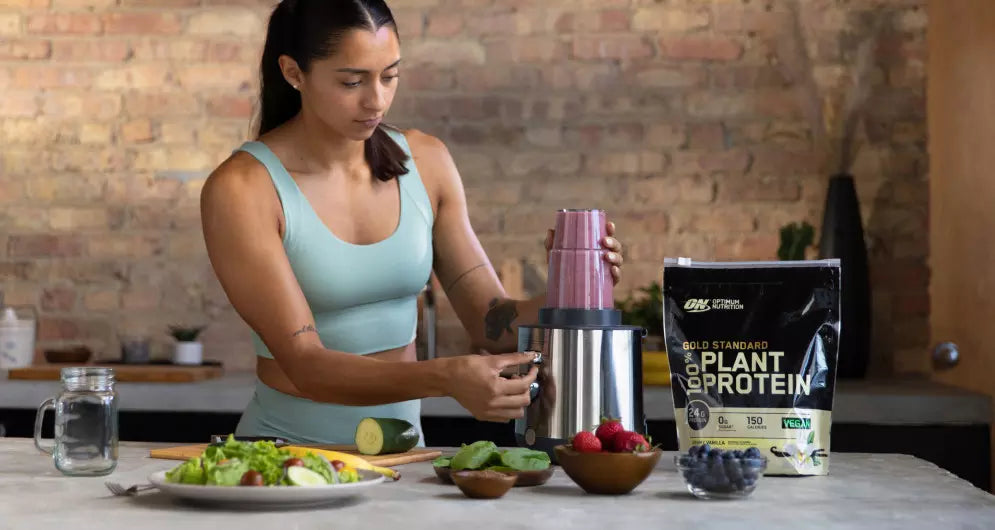Protein is an important macronutrient in any diet, especially for athletes and fitness enthusiasts. But many people mistakenly think that more plants, and less meat, equals lower protein intake. Let’s look at some ideas on how you can get more plant protein within a flexitarian diet.
Tip 1 | Balance animal and plant protein sources
Adding sources of plant protein doesn’t have to be an ‘either / or’ proposition. Combining protein sources is a great way to round out your diet. And if you’re looking to minimize animal products, just scale them back in your recipes. Then, add more plant protein sources like beans or nuts.
- Beef and bean chili
- Chicken quesadilla with black beans
- Chicken pad Thai with peanuts
Tip 2 | Enhance dishes you typically make
Once again, you don’t have to choose one or the other. You can enhance meals you already enjoy with an extra punch of protein by adding a side dish, using a plant-based condiment, or simply swapping out a traditional ingredient for something else.
- Turkey sandwich with a hummus spread
- Lasagna made with lentil noodles, spinach, and vegan cheese
- Baked chicken with a quinoa salad
Tip 3 | Set a ‘plant day’
You don’t have to go full plant right away! One or two “plant days” days each week makes meal prep a little less intimidating in the beginning. If you’re using complete plant protein sources (soy, quinoa) or combining the right veggies, you won’t miss out on your muscle fuel!
- Veggie burgers
- Eggplant parmesan
- Black bean enchiladas
Tip 4 | Go international
Plant-based ingredients are the star of the show in many cuisines. Dishes born in the Mediterranean, Japan, Korea, Thailand, and the Indian subcontinent can offer both variety and sumptuous flavors – all while providing you with plenty of protein.
- Cashew veggie stir fry with tofu
- Chickpea curry
- Greek salad pitas
Tip 5 | Snack on plants
Snack time is the perfect opportunity to start small without a lot of fuss. Nutritious, plant-based nibbles can seriously reduce the number of junk calories in your diet.
- Almond butter and sliced apples
- Trail mix with cashews, almonds, pumpkin seeds, dried fruit, and dark chocolate
- Hummus and edamame
Tip 6 | Add in plant-based milks
There are plenty of alternatives to dairy milk. Rice, oat, soy, hazelnut, and coconut milks (among countless others) offer unique flavors, textures, and nutritional content. Soy milk offers the highest protein content and is considered a complete protein. If you’re looking to ramp up your protein intake for muscle recovery, it’s the perfect option.
- Coffee with soy milk
- Soy matcha latte
- Mixed berry soy smoothie
Tip 7 | Supplement with plant proteins as needed
A food-first approach is the best way to get the nutrients you need, but if you need more protein in your diet, consider adding a plant-based protein supplement. You can use them any time of day, but they’re especially useful as a post-workout recovery shake. You can even add them to snacks and meals.
- Optimum Nutrition Gold Standard 100% Plant Protein
- Vegan
- 24 grams of plant protein per serving
- Blend of pea, rice, and fava bean protein
- 9 essential amino acids / BCAAs
We’ve mentioned it a couple of times above, but let’s say it once more for the people in the back – you don’t have to choose between plant and animal sources of protein! A flexitarian diet suits many people, and the substitution of or shift away from animal products can be accomplished gradually.
Remember – it’s important to get the complete profile of essential amino acids – the ones your body doesn’t make on its own. You can get them from meat and dairy foods, plant-based foods like soy and quinoa, in a supplement like Gold Standard 100% Plant Protein, or a sampling of them all.





